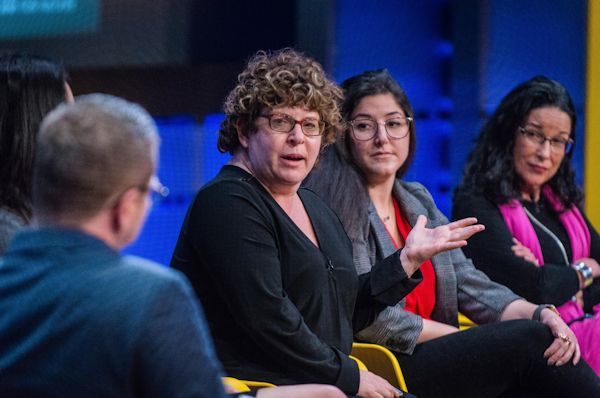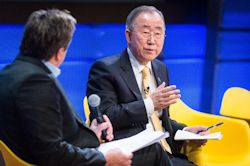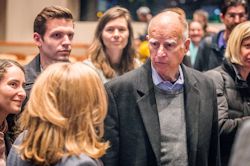SEJournal Online is the digital news magazine of the Society of Environmental Journalists. Learn more about SEJournal Online, including submission, subscription and advertising information.
 |
 |
| Top environment journalists speaking at an SEJ discussion moderated by former SEJ President Bobby Magill of Bloomberg (far left) included Lisa Friedman of the New York Times (gesturing, at center), Jennifer Hijazi of E&E News (second from right) and Trish Wilson of the Washington Post (far right). Photo: SEJ/Kevin Manuel. Click to enlarge. |
2020 Guide: Climate Concerns Dominate Reporting Outlook at SEJ Annual Event
By Joseph A. Davis
EDITOR'S NOTE: This story is part of our 2020 Journalists’ Guide to Energy & Environment, a series of special reports from SEJournal that looks ahead to key issues in the coming year. Visit the full guide for more. Watch video of the event. Photos.
The Society of Environmental Journalists’ annual look-ahead to environment and energy news in 2020 drew a crowd of some 300 (with more than 200 watching the live webcast) at National Geographic Society headquarters in Washington, D.C., Jan. 24.
And the overwhelming topic of discussion — climate change.
The subject came up at the start of the afternoon gathering, with an appearance by headliner Ban Ki-moon, the former United Nations Secretary-General who helped lead the world’s nations to the 2015 Paris climate agreement.
Just one day before, with climate change and nuclear weapons serving as what he called “the two most serious existential threats” to humanity, Ban had helped unveil an update of the Bulletin of the Atomic Scientists symbolic “Doomsday Clock.” The clock’s ticking closer to midnight, Ban said, “really highlights the urgency and seriousness and danger humanity is now facing.”
“You journalists have a critically important
role to convey the truth, so that you can
hold political leaders … to account.”
— Ban Ki-moon, former U.N. Secretary-General
But according to the former U.N. leader, while people automatically fear nuclear threats, not so with climate change, adding: “Never in the past have we experienced such devastating climate change as now. You journalists have a critically important role to convey the truth, so that you can hold political leaders … to account.”
Ban also called President Donald Trump’s move to withdraw the United States from the Paris Agreement “politically speaking, very short-sighted, morally irresponsible, scientifically dead wrong.”
 |
| Former U.N. Secretary-General Ban Ki-moon headlined the Jan. 24 program in a Q&A with former SEJ President Jeff Burnside. Photo: SEJ/Kevin Manuel. Click to enlarge. |
When asked if the United States could rejoin the pact, however, he did add: “You are welcome any time, even tomorrow.”
‘Environment stories are front-page stories’
It was the eighth year the SEJ has held the Journalists’ Guide to Energy & Environment, although it was the first time hosted by National Geographic Society, which sponsored the forum with the Wyss Campaign For Nature.
Journalists and other attendees were warmly received by Kalee Kreider, a familiar face to many environmental reporters and who was recently installed as chief of media and public affairs at National Geographic.
Another encouraging welcome came from Meera Subramanian, SEJ’s new president, who noted that SEJ membership is currently at a historic high and who spoke of the growing importance of environmental journalism in an era when environmental stories show up in the science pages, the business section, the food section, real estate section and arts section.
“Environment stories are front-page stories.
They’re every-page stories. They’re
everywhere stories and they’re everybody stories.”
— Meera Subramanian, SEJ president
“Environment stories are front-page stories,” Subramanian said. “They’re every-page stories. They’re everywhere stories and they’re everybody stories.”
Independent journalist Jeff Burnside, himself a former SEJ president, summarized the published version of the Journalists’ Guide, which has reports on EPA’s future, nuclear power, transportation legislation, the decline of coal, the algae scourge, freedom of information, the 2020 elections, drilling on public lands, agriculture impacts, grazing and appropriations.
Climate a factor in 2020 elections?
The heart of the event was a panel discussion moderated by Bloomberg journalist (and another past SEJ president) Bobby Magill, who questioned five noted environmental journalists on what stories they saw coming in 2020.
Veteran climate reporter Lisa Friedman, now at the New York Times as part of a 16-person climate desk, joked about her job that “I write obituaries for climate regulations.” This year, that is expected to include the rollback of auto emissions regulations and numerous other climate-related curtailments and legal wrangles.
Looking ahead, Friedman sees herself and her Times teammates focused increasingly on the role climate will play in the coming elections. Friedman also said all eyes will be on the United States at the next United Nations climate meeting, COP26, which happens just after the November vote.
Jennifer Hijazi, who covers climate law for the E&E News family of publications, said she expects to be busy in 2020 covering various “buckets” of climate liability cases. Various states and other parties (e.g., shareholders and consumers) still have many pending suits against oil, gas and other fossil-fuel companies for the damages and costs of climate change.
 |
| Former California Gov. Jerry Brown, in attendance at the annual SEJ look-ahead discussion. Photo: SEJ/Kevin Manuel. Click to enlarge. |
Courts, Hijazi suggested, have emerged as a forum for efforts to resolve issues the regulatory arena has failed at. She expects to spend more time in 2020, for instance, covering climate conflicts in international human rights law.
Trish Wilson, the editor who leads a comparatively newly formed climate and environment team at the Washington Post, said that news organization will be looking for ways to tell complicated climate stories in ways that engage “real people” outside the Beltway. She mentioned the Post’s story on outdoor air conditioning at soccer stadiums in Qatar.
The Post’s focus, she said, will be on solutions. “The price of modern life is the planet," she quipped.
Robert Kunzig, an environmental editor at National Geographic magazine, acknowledged that while “we have a big planet to cover,” climate would be a major focus, especially with the COP26 U.N. meeting coming up. Kunzig added that he would be looking at the numbers for signs of change: “Is this going to be the year when emissions really plateau?”
‘Forever chemicals,’ biodiversity, economy also issues to note
Although climate monopolized the discussion, it was not the only red flag raised for 2020.
For instance, panelist Sylvia Carignan, who covers chemical pollution and Superfund for Bloomberg Environment, said a sure newsmaker in the coming year would be PFAS — a large family of fluorinated substances often tagged in headlines as “forever chemicals” and commonly used in industrial products.
PFAS are raising concerns because of widespread contamination (most Americans have some levels in their blood) and looming conflicts over how to regulate them.
“I think it might actually be the
year that climate change matters.”
— Lisa Friedman, New York Times
Biodiversity will continue to be a key coverage area for National Geographic, added Kunzig, with another COP coming in 2020, this one on the U.N. Convention on Biological Diversity (together with a host of related biodiversity meetings).
Kunzig also said he expects “the circular economy” to emerge as an issue.
But much of the panel discussion did circle around climate change, and especially the still-undetermined role that the topic will play in the November elections.
Said Friedman, pointing to the seven-hour CNN candidates forum on the subject: “I think it might actually be the year that climate change matters.”
Joseph A. Davis is a freelance writer/editor in Washington, D.C. who has been writing about the environment since 1976. He writes SEJournal Online's TipSheet and Reporter's Toolbox columns. Davis also directs SEJ's WatchDog Project and writes WatchDog Tipsheet, and compiles SEJ's daily news headlines, EJToday.
Watch video of the event:
* From the weekly news magazine SEJournal Online, Vol. 5, No. 4. Content from each new issue of SEJournal Online is available to the public via the SEJournal Online main page. Subscribe to the e-newsletter here. And see past issues of the SEJournal archived here.












 Advertisement
Advertisement 



